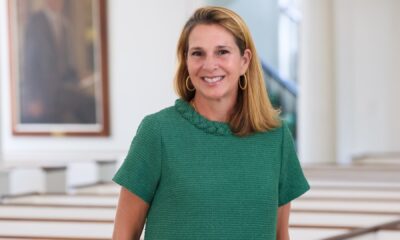Education
Students Call for Community Connections and More Hugs

During a recent all-school meeting at Western Reserve Academy, a student named Alice delivered an unexpected yet heartfelt message: “The world needs more hugs.” This statement resonated with her peers, resulting in enthusiastic applause rather than the usual teenage derision. Alice’s simple call for connection reflects a deeper need among adolescents for community and belonging, especially in a world increasingly marked by isolation.
As the academy prepares for its historic bicentennial in 2026, Suzanne Walker Buck, the first female head of the institution, emphasizes the importance of nurturing a supportive environment for students. Recent findings from the Global Flourishing Study (GFS), which surveyed over 200,000 individuals across 22 countries, reveal a troubling trend: while happiness has traditionally peaked in youth, this pattern is changing. The GFS indicates that flourishing—a holistic state of well-being—remains stagnant for individuals aged 18 to 49, only to rise later in life.
Understanding the Decline in Youth Flourishing
Members of Generation Z report significant challenges related to mental health, meaningful relationships, and a sense of purpose. Contributing factors include increasing loneliness, exposure to social media, and a decline in participation in group activities. The GFS findings are particularly striking, as they show that youth in wealthier nations, such as the United States, Germany, and the United Kingdom, experience lower levels of flourishing compared to their peers in lower-income countries. This suggests that financial wealth does not equate to emotional well-being.
What, then, fosters true flourishing? Researchers from Harvard and Baylor Universities, who authored the GFS, identify several key components: happiness and life satisfaction, mental and physical health, a sense of meaning and purpose, character and virtue, close social relationships, and financial security. Most of these elements thrive within a strong community, which schools can significantly help to create.
Building Community through Rituals and Routines
Despite the myriad challenges faced by educators, there are opportunities to proactively build community among students. Rituals serve as a foundational element for fostering this sense of belonging. At Western Reserve Academy, the school year kicks off with a convocation—a gathering that symbolizes unity and shared purpose. This year, students celebrated the academy’s upcoming 200th birthday with festive birthday hats and noisemakers, reinforcing the importance of collective experiences.
According to Jonathan Haidt, author of “The Anxious Generation,” rituals act as “social glue” that strengthens community ties and promotes well-being. He notes the evolutionary significance of these rituals, which have been diminished during the COVID-19 pandemic due to school closures and social distancing. The loss of in-person interactions has had a lasting impact, but there is hope for recovery through intentional communal activities.
At Western Reserve Academy, initiatives such as the “Peace, Love and Light” series invite students to engage in discussions about current events that affect their lives. Contrary to expectations, these gatherings have been well-received, suggesting a deep-seated desire among students for connection and dialogue. Dr. Lisa Damour, a respected adolescent mental health expert, emphasizes that a combination of structure and warmth provides children with the security needed to thrive independently.
Creating a sense of community is a circular process requiring participation and acceptance. It involves fostering a sense of belonging, establishing routines, and providing invitations for involvement. Students should feel free to express themselves and share diverse ideas, as this openness cultivates an environment where everyone can flourish. As Buck aptly concludes, “the world, and our children, need more hugs,” highlighting the essential role of community in supporting youth development.
Readers are encouraged to contribute their thoughts to the Opinion page. Submissions of up to 500 words may be sent to Ann Norman at [email protected], accompanied by a brief biography and headshot.
-

 Technology5 months ago
Technology5 months agoDiscover the Top 10 Calorie Counting Apps of 2025
-

 Health3 months ago
Health3 months agoBella Hadid Shares Health Update After Treatment for Lyme Disease
-

 Health3 months ago
Health3 months agoErin Bates Shares Recovery Update Following Sepsis Complications
-

 Technology4 months ago
Technology4 months agoDiscover How to Reverse Image Search Using ChatGPT Effortlessly
-

 Technology2 months ago
Technology2 months agoElectric Moto Influencer Surronster Arrested in Tijuana
-

 Technology1 month ago
Technology1 month agoDiscover 2025’s Top GPUs for Exceptional 4K Gaming Performance
-

 Technology5 months ago
Technology5 months agoMeta Initiates $60B AI Data Center Expansion, Starting in Ohio
-

 Technology5 months ago
Technology5 months agoRecovering a Suspended TikTok Account: A Step-by-Step Guide
-

 Health4 months ago
Health4 months agoTested: Rab Firewall Mountain Jacket Survives Harsh Conditions
-

 Lifestyle5 months ago
Lifestyle5 months agoBelton Family Reunites After Daughter Survives Hill Country Floods
-

 Technology4 months ago
Technology4 months agoHarmonic Launches AI Chatbot App to Transform Mathematical Reasoning
-

 Technology3 months ago
Technology3 months agoUncovering the Top Five Most Challenging Motorcycles to Ride











